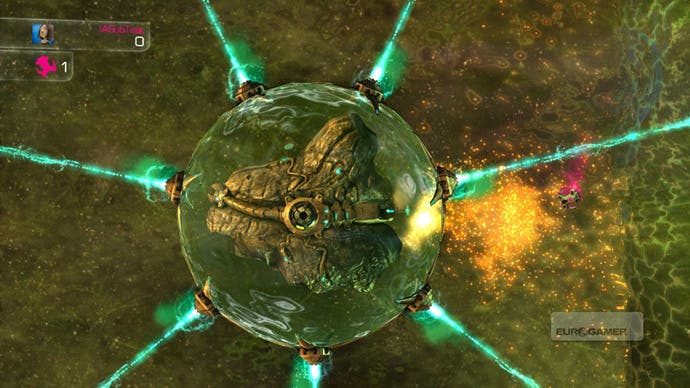Ion Assault
Splash damage.
Case, the lead character in William Gibson's excellent Neuromancer, has a point when he talks about his brain occasionally moving faster than his consciousness. It's a zen-like state in which trying to process what you're doing is actually an impediment; in which it's best to simply let your hard-wired responses do the work without going through the filter of personality. He refers to these as 'moments of grace', and they'll be familiar to anyone who's ever progressed very far in a modern twin-stick shooter.
Ion Assault is a fine example of the form. The action takes place in square arenas - fenced-off bits of space with bouncy, coruscating borders. Colourful enemies warp in almost continuously and your small ship is forced to manoeuvre through the thickening crowd to survive, picking off foes and grabbing the resulting score orbs. Blistering amounts of visual and aural information assault your senses.
So far, it's so Geometry Wars, but Ion Assault has a couple of clever tricks up its sleeve, and one mechanic in particular which makes it a very refreshing take on what has become a standard model. The ions of the game's title are tiny particles, spread around each arena like so much spilt milk on the vacuum formica of space. Holding the left trigger soaks up ions and holds them in a charged plasma field, and this storm of particles not only protects your craft from frontal assault, damaging enemies and asteroids if they come too close to the business end, but also powers your weapon. The more you charge, the more powerful the shot. Not a new concept in itself, but beautiful in execution.

Releasing clouds of ions shoots them directly forwards in a loose bunch, but it's when they come into contact with something, be that border or foe, that the pretties are really set free. Ions regain their individuality once released, with each treated as a separate physical object. This means the blast behaves more like liquid, splashing into and flowing around objects, separating and dissipating gradually and yet still dealing some damage as long as the ions retain some heat.
Because the ions are now spread across the stage, pooling in corners or around clusters of enemies, the player is forced to stay on the move to collect them again. There's no turtling in a corner. With only a limited, albeit generous, number of ions on each stage, it makes sense to try and corral them to facilitate faster charging. Being devoid of ion charge also means that you'll lose the protection of their glowing torus, leaving your ship even more vulnerable.

